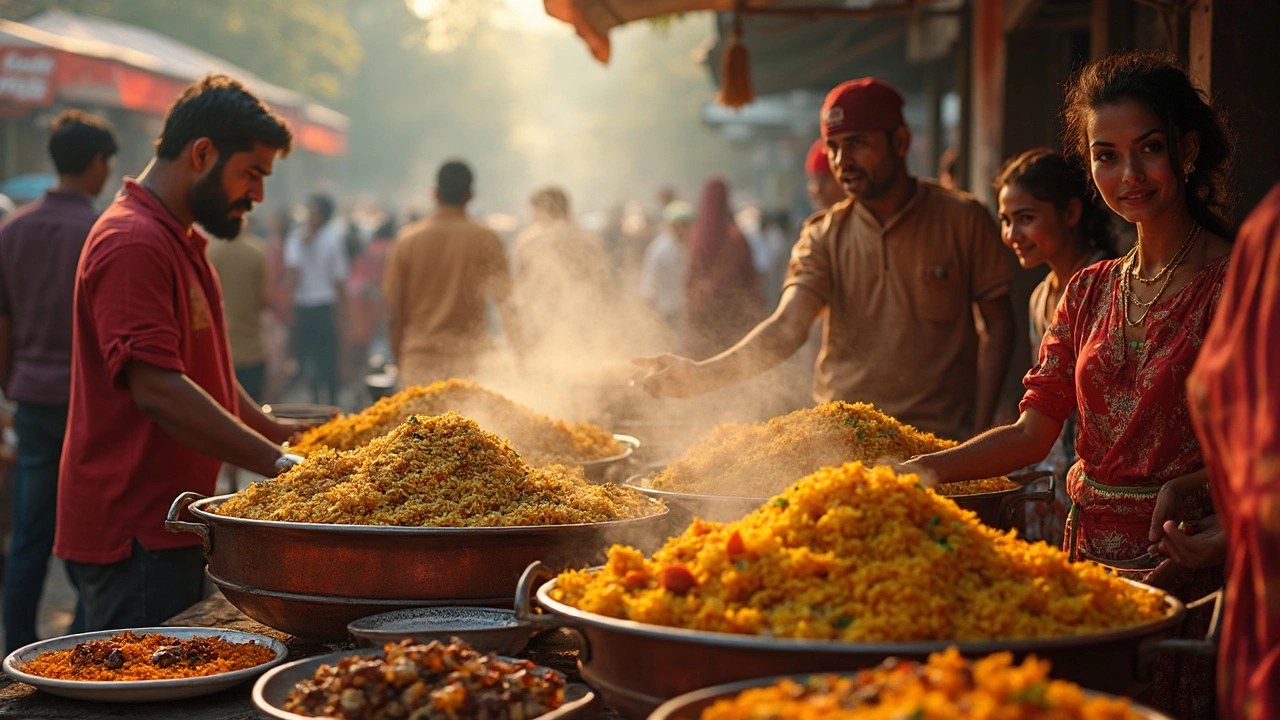Ask ten people across India about their favorite dish, and biryani is going to pop up again and again. It’s not just a meal—it’s a mood, an event, and in some families, pretty much a weekly ritual when everyone turns foodie. But why does this one dish have people straight-up obsessed?
Biryani isn’t some high-flying restaurant food—it's what you'll find at train stations, weddings, quick office lunches, and lazy Sunday feasts. There’s so much hype that festivals focused on biryani draw serious crowds in cities like Hyderabad and Lucknow. Last year alone, Swiggy (yeah, that food delivery app) reported biryani was their most-ordered dish, beating out pizza and burgers in the food race.
So, what makes biryani tick? Think soft rice, spiced meat or veggies, and the kind of aroma that makes people lose their patience outside the kitchen. It unites spice fans, meat lovers, and vegetarians—every region has its own spin. And unlike a regular rice dish, biryani is layered with stories and history. If you’ve never tried it, you’re seriously missing out on one of India’s true food icons.
- Why Biryani Has a Fan Base Like No Other
- Secret Tips to Spot (or Make) Great Biryani
- Regional Twists on a Timeless Favorite
- When and Where Biryani Rules the Table
Why Biryani Has a Fan Base Like No Other
Biryani gets street cred in India that few other foods do. You see families stash away grandma's biryani recipe like it's state secret, and travel influencers doing "biryani crawls" across cities. But where did this hype even start?
The story goes way back, all the way to Persian influences and Mughal kitchens. Some claim Mumtaz Mahal (yep, the Taj Mahal queen) pushed her palace cooks to make a wholesome meal for her soldiers. Fast forward, and you now get biryani as army rations, homemade Sunday comfort, and even on posh restaurant tables.
- Biryani isn’t tied to just one region—Hyderabadi, Lucknowi, Malabar, Kolkata, and more each have rabid fans and their own loyal food shops.
- People love that it’s all-in-one: carbs, protein, spices, and often a little oil for flavor. No need for fancy sides.
- The dish has a social angle—nobody makes biryani just for themselves. It’s party food, community food, festival food.
- Today, biryani is the most-ordered dish on apps like Zomato and Swiggy for five years straight.
The numbers don’t lie. Check this out:
| Platform | Biryani Orders in 2023 | Second Most Ordered Food |
|---|---|---|
| Swiggy | 2.28 crore plates | Pizza |
| Zomato | 1.95 crore plates | Burger |
That’s a whopping 42 lakh plates a month! For real, Indian food gets the most love when it comes as flavor-loaded biryani. It never gets boring, and there’s always a new twist to try wherever you go.
If you’re wondering what to try or serve next time the squad's coming over, biryani is a safe bet. Even picky eaters usually cave in when that signature aroma hits the room.
Secret Tips to Spot (or Make) Great Biryani
Nailing great biryani is all about details. If you want a plate that blows people away—or if you’re on the lookout for the real deal at a restaurant—these are the signs and steps you shouldn’t ignore.
Let’s break down what separates “meh” biryani from the kind you’ll dream about.
- Indian food spotlight: The best biryani always uses long-grain basmati rice. If the grains are clumpy and sticky, that’s a big red flag. Real biryani rice should be light and each grain should stay separate.
- The meat or veggies shouldn’t be bland. That flavor needs to reach the center—ask the cook if ingredients are marinated for at least two hours. The more time, the bigger the punch of flavor.
- Look for the “dum” cooking technique. Good biryani gets sealed for a slow steam. That means all the layers—rice, curry, fried onions—get cozy with the spices. This is what gives you that wow factor when you open the pot.
- The biryani should smell amazing before you even see it. Saffron, fried onions, maybe a hint of mint and cardamom—if your senses aren’t hit instantly, it’s not there yet.
- Grease is good, but not too much. A little oil on your fingertips means the rice has soaked up flavors, but swimming in ghee or oil is a no-go.
Trying to make it yourself? Stick to these basics:
- Soak your basmati rice 30 minutes before cooking. It gives that perfect texture.
- Don’t rush the layers. Start with half-cooked rice at the bottom, then the marinated meat or veggies, then more rice on top. Add fried onions between layers for legit taste.
- Seal the pot with dough or a tight lid and keep the flame low for about 20-30 minutes. That’s how you get the dum magic.
- Let it rest for 10 minutes after cooking before you open up. It’s tough, but the flavors settle in nicest this way.
Spotting or making great biryani isn’t about fancy tricks—it’s all about patience and knowing the steps matter at every stage. Next time you take a bite, check for these signs. It could be love at first spoonful.

Regional Twists on a Timeless Favorite
What’s wild about biryani is how every part of India seems to have its own rules for making it. Forget following just one recipe—walk down the same street in Hyderabad and you’ll spot two places with totally different takes. Let’s break down a few true icons so next time you’re ordering or traveling, you know just what you’re getting.
- Hyderabadi Biryani – Probably the most hyped biryani, it’s cooked using the "dum" method. Layers of raw marinated meat and basmati rice get sealed with dough, then slow-cooked. Expect spicy flavors, fried onions, and the classic hit of boiled eggs or mutton. Locals will tell you it’s not authentic unless it’s cooked this way.
- Kolkata Biryani – This one has a totally unique vibe. Railway history fans, listen up! When the Nawab of Awadh was exiled to Kolkata, he brought biryani culture along, but budget constraints meant they added potatoes to the dish. So yes, you’ll find big chunks of aloo with fragrant rice, light spices, and sometimes a subtle whiff of rose water.
- Lucknowi (Awadhi) Biryani – Known for its mellow flavors and crazy attention to detail. The rice and meat are cooked separately, then layered and finished together. Saffron and kewra water give it that signature aroma. You won’t find super spicy notes here, but it’s rich and kind of melts in your mouth.
- Thalassery Biryani – If you ever end up in Kerala, try this one. Instead of long-grain basmati, they use a much shorter rice—jeerakasala. It’s lighter but loaded with flavor thanks to spices and ghee. Fish biryani is big here, another total twist from the rest of India.
- Ambur Biryani – This Tamil Nadu staple is all about simple flavors, cooked quickly compared to dum. The flavor is fiery, usually made with small grain seeraga samba rice, and often comes with brinjal gravy and raita on the side.
Don’t think you have to stick to the classics, though. Across the country, you’ll find veggie, chicken, mutton, egg, and even prawn biryanis with local spins. If you have dietary restrictions or preferences, you can always find a version. The adaptability and culture built around biryani are what make Indian food stand out. Taste-testing local varieties is kind of like taking a road trip through India—each spot gives you a new story and a flavor punch you can’t forget.
When and Where Biryani Rules the Table
Biryani isn’t tied to any single tradition or region, which is why you find it just about everywhere in India—from five-star hotels to busy roadside stalls. But there are certain moments and places where this dish takes center stage, and its true fans know exactly when it’s biryani’s time to shine.
If you walk into any Indian wedding, odds are you’ll spot a giant vessel of biryani. It’s almost an unspoken rule—no celebration, especially weddings, feels complete without it. The same goes for big family gatherings, Eid festivities, and city food festivals. In Hyderabad, the first Friday of every month sees a noticeable spike in biryani sales, probably because people want to kick off the weekend with something special.
Don’t think biryani is only for special days, though. In cities like Chennai, Mumbai, and Kolkata, lunch hours see whole office teams pooling money for a group biryani order. Train journeys are another hotspot. Anyone who’s ever crossed India by train knows that railway platform biryani is almost a cult classic in itself—cheap, tasty, and filling.
Here’s a look at when and where Indian food fans turn to biryani the most, according to 2024 online food delivery and event stats:
| Occasion/Place | Why Biryani? | Notable Details |
|---|---|---|
| Weddings & Family Events | Feeds many, celebrates togetherness | Almost 75% of urban weddings serve biryani (Swiggy 2024) |
| Eid & Main Festivals | Tradition, flavor, community | Massive spike in orders, especially mutton and chicken |
| Lunch Rush in Cities | Quick, tasty, filling meal | Most-ordered office group lunch (Zomato 2024) |
| Train Journeys | Portable, hearty, always available across stations | Kolkata’s and Secunderabad’s platform biryanis have local cult status |
| Weekend Treats | End-of-week reward, comfort food | Biryani orders shoot up by 30% on Fridays (Swiggy 2024) |
If you want to join the club of true biryani lovers, try grabbing a plate at an authentic joint when the place is packed—fresh batch, lively crowd, unbeatable atmosphere. You’ll quickly see why no other dish has its level of loyal following in the everyday life and big moments across India.
